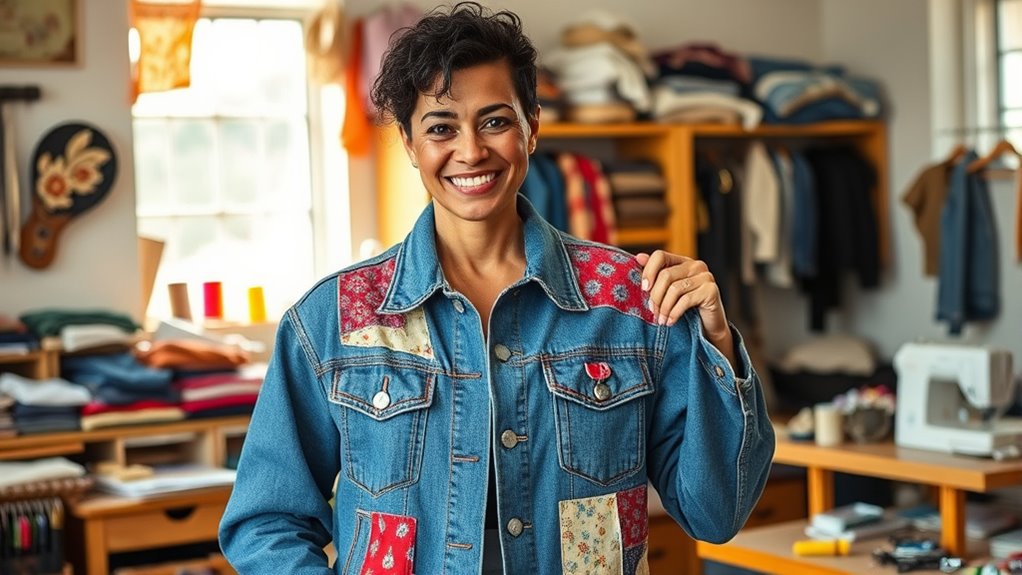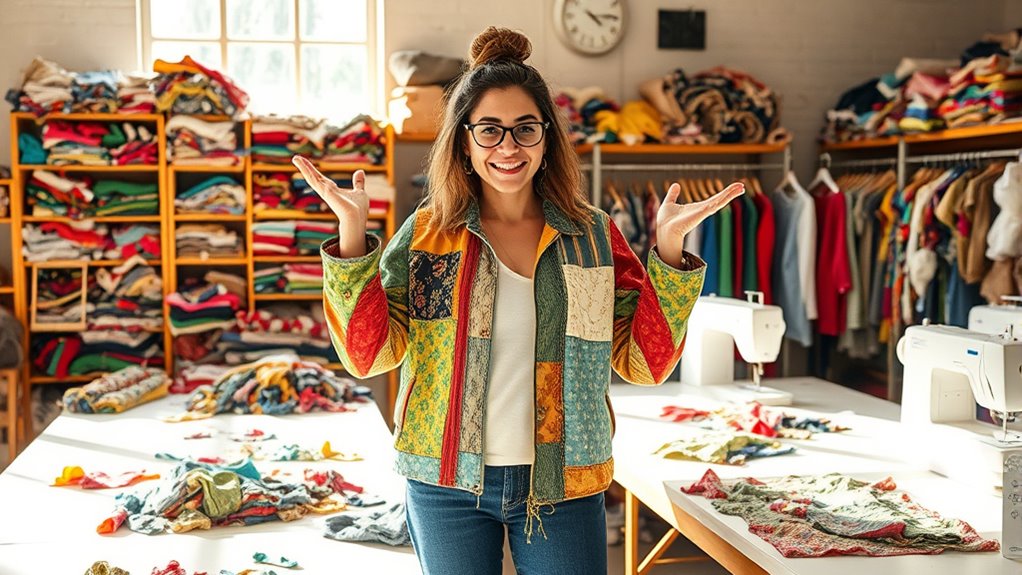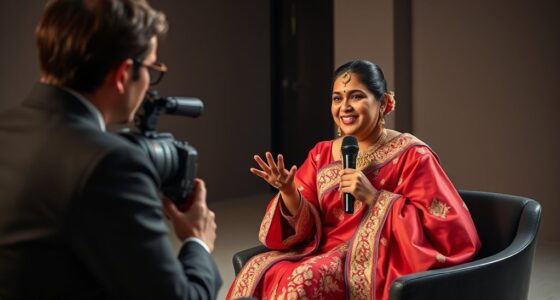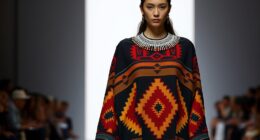A circular fashion advocate emphasizes that upcycling transforms old garments into new, stylish pieces, reducing waste and conserving resources. By choosing sustainable materials and supporting ethical brands, you help shift the industry toward a more responsible future. Educating yourself about the lifecycle of clothing and craftsmanship behind each upcycled item boosts mindful consumption. Your actions can inspire others and drive change. If you stay curious, you’ll discover effective ways to incorporate upcycling into your wardrobe and lifestyle.
Key Takeaways
- Upcycling transforms old garments into new, unique pieces, reducing textile waste and promoting a circular economy.
- Consumer education is vital to recognize authentic upcycled products and support transparent, sustainable brands.
- Informed choices resist fast fashion’s throwaway culture, fostering creativity and personal expression through upcycled fashion.
- Emphasizing sustainable materials and ethical practices decreases environmental impact and extends garment longevity.
- Mindful consumption and storytelling behind upcycled items inspire broader industry change and foster resilience in fashion.

As the fashion industry faces mounting environmental challenges, upcycling has become a crucial strategy for creating sustainable style. You might wonder how this approach can transform your wardrobe and the planet simultaneously. It all begins with understanding the importance of sustainable materials. Upcycling involves repurposing existing garments or textiles, reducing waste, and minimizing the demand for new resources. By choosing pieces made from sustainable materials—like organic cotton, hemp, or recycled fabrics—you actively support a circular economy that values longevity over disposability. These materials typically require fewer chemicals and less water during production, making them a smarter choice for the environment. When you make a conscious effort to seek out upcycled or sustainably made pieces, you’re not just dressing stylishly; you’re contributing to a larger movement that aims to lessen the fashion industry’s ecological footprint.
But sustainable materials alone aren’t enough. Consumer education plays an essential role in shifting habits and perceptions around fashion. When you become more informed about the lifecycle of garments and the impact of your purchasing choices, you can make better decisions. This might mean learning how to identify authentic upcycled products or understanding how to care for them properly to extend their lifespan. Educating yourself on the benefits of upcycling also involves recognizing the value of craftsmanship and the stories behind each piece. As a consumer, your awareness can influence brands to prioritize sustainability and transparency, encouraging more companies to adopt ethical practices. You can support local artisans, buy from brands committed to upcycling, or even try your hand at DIY projects, transforming old clothes into something new and unique.
The more you educate yourself and others about sustainable materials and the importance of upcycling, the more you’ll see how powerful your choices are. Each purchase becomes an act of resistance against fast fashion’s throwaway culture. You’re not just buying a piece of clothing—you’re making a statement about your values and your commitment to environmental stewardship. Upcycling fosters creativity and individuality, giving you the opportunity to craft personalized items that reflect your style and ethics. When you prioritize sustainable materials and invest in your knowledge, you’re helping to reshape the fashion landscape into one that’s more mindful, resilient, and respectful of the planet. Additionally, understanding the role of attention in creative practice can help you become more mindful of your consumption habits and their impacts. Ultimately, your informed choices can inspire others, creating a ripple effect that accelerates the shift toward a truly circular fashion industry.
Frequently Asked Questions
How Can Beginners Start Practicing Upcycling Today?
You can start practicing upcycling today by exploring DIY tutorials online that show simple, creative projects. Attend beginner workshops to learn techniques firsthand and get inspired. Gather old clothes or fabric scraps, then experiment with cutting, sewing, or embellishing them into new, stylish pieces. Don’t worry about perfection—focus on having fun and reducing waste. With a little practice, you’ll turn discarded items into unique, eco-friendly fashion!
What Are Common Challenges Faced by Upcyclers?
Like Pandora’s box, upcyclers often face challenges, especially sourcing quality fabric and maintaining design originality. You might struggle to find sustainable materials that fit your vision, or feel limited by what’s available. Balancing creative expression with environmental goals can be tough, and staying unique in a sea of recycled items demands innovation. Overcoming these hurdles requires patience, resourcefulness, and a passion for transforming old into extraordinary new pieces.
How Does Upcycling Impact the Environment Long-Term?
Upcycling positively impacts the environment long-term by reducing waste and conserving resources. When you choose sustainable materials, you help lower pollution and energy consumption associated with manufacturing new products. This practice promotes ecological benefits by extending the life of textiles and minimizing landfill overflow. Your efforts in upcycling contribute to a healthier planet, encouraging a circular economy where waste becomes a resource, ensuring a sustainable future for generations to come.
Are There Legal Considerations When Upcycling Brand-Name Textiles?
You should be aware that legal regulations can impact your upcycling efforts, especially when using brand-name textiles. Intellectual property laws protect trademarks and designs, so repurposing branded items might infringe on rights if not carefully managed. Always review legal considerations, obtain necessary permissions, and respect trademarks to avoid legal issues. Staying informed about intellectual property rights helps you upcycle responsibly and avoid potential lawsuits.
What Tools or Materials Are Essential for Effective Upcycling?
To effectively upcycle, you need essential tools like scissors, sewing machines, and fabric adhesives. Gather sustainable fabrics such as organic cotton or recycled materials to guarantee eco-friendliness. Use creative techniques like patchwork, embroidery, or dyeing to transform old textiles into new pieces. These tools and methods help you maximize your upcycling efforts, making your designs unique while reducing waste and promoting circular fashion.
Conclusion
By embracing upcycling, you’re not just reducing waste—you’re making a real impact. Did you know that the fashion industry is responsible for 10% of global carbon emissions? That’s more than all international flights and maritime shipping combined. Every time you choose upcycled clothing, you’re helping cut emissions and support a more sustainable future. So, get inspired and start transforming your wardrobe—your choices can truly make a difference in creating a circular fashion world.








